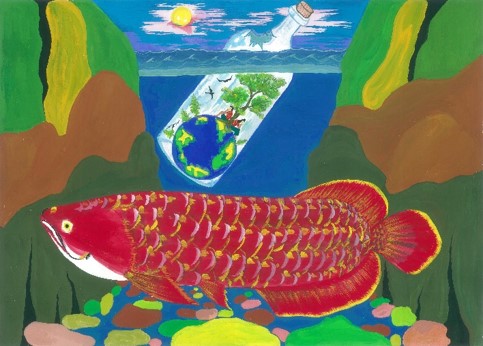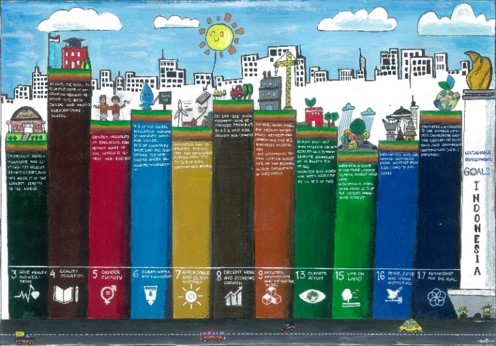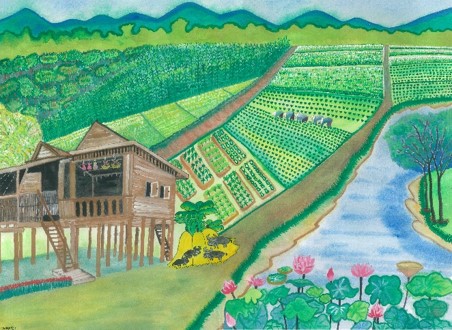2020 International College Drawing/Painting Competition
2020年度國際學院繪畫比賽
Theme (主題):
- SDGs concerns in my country (我的國家對聯合國SDGs永續發展目標的關注)
SDGs refer to the 17 United Nations’ Sustainability Development Goals. Participants are welcomed to present a drawing/painting about any aspect related to at least one of the seventeen SDGs about your country. These aspects may cover current situation, problem, solution, vision, etc.
SDGs是指聯合國193個會員國共同通過的至2030年永續發展議程的17項永續發展目標(Sustainable Development Goals, SDGs)。歡迎您以繪畫的方式來呈現您國家/地區對這17個SDGs目標其中之一(或更多)的關注與關聯,這些關聯可包括您國家/地區當前的狀況、問題、解決方案或願景等等。
First Prize
第一名

- The Tegalan (爪哇島的後花園)
-
Sabiha Ramadani (莎冰荷)
Ph.D. student, DTAIC (熱帶農業暨國際合作系博士生)
Indonesia (印尼) - Tegalan is a back garden in Java Island. It reflects SDGs 15 because of its high biodiversity due to the large number of plants growing there. There are plants such as fruit trees, vegetables, medicinal plants, herbs, and even livestock enclosures. Generally, Tegalan is in a rural area where rural communities in Indonesia have large tracts of land so they use the land to grow crops. The high biodiversity and cool countryside air attract birds to inhabit.
Second Prize
第二名

- “Río Plátano”Biosphere (雷奧普拉塔諾生物圈)
-
Raquel Ayestas (菈葵娥)
Senior, DTAIC (熱帶農業暨國際合作系大四生)
Honduran (宏都拉斯) - The Río Plátano Biosphere is the largest protected area in the country where not only an abundance of biodiversity resides, but it also harbors archaeological and cultural values. Protecting this land is significant for the lives of over 2,000 indigenous people (“Miskito people”) who preserve their traditional way of living and homeland. This drawing reflects the abundance of life gifted by the riches of this land. The woman represents the “Miskito People”, the jaguar and the macaw represent the flora and fauna, and the river represents the entire watershed of the “Río Plátano”, which extends all the way from the mountains down to the coast.
Third Prize
第三名

- Arowana (龍魚)
-
David Anderson (安達偉)
Ph.D. student, DTAIC (熱帶農業暨國際合作系博士生)
Indonesia (印尼) - This painting was inspired by one of the very rare fishes in my birthplace, Indonesia. When I came to NPUST, one of my Taiwanese laboratory friends invited me to visit the PABP Aquaculture Showroom. I saw a lot of interesting fish species there and one of the most interesting things for me was Arowana fish because it reminded me of my home in Indonesia. The fish is very valuable. Arowana is almost extinct in Indonesia. This painting contains various aspects of SDGs such as life below water, life on land, humans with all their problems. This painting also reminds us that our world is in danger but we are often unaware of. Save our planet and love our earth!
Excellent Artwork Award
佳作

- Envision (預見)
-
Simran Kayastha (葛亞莎)
Junior, DTAIC (熱帶農業暨國際合作系大三生)
Nepalese (尼泊爾) - This picture is a visualization of our sustainable future, where all creatures on earth live a happy and a co-operative life. A future where all the SDG’s are met also peace and harmony are maintained. Everyone is respectful of each other; we flourish and grow together by supporting each other.
Excellent Artwork Award
佳作

- SDGs concerns in my country - Some for you, some for me.(我國對SDGs的關注 - 有些為你,有些為我)
-
Su-Chiu (Sonia) Hung (洪素秋)
M.S. student, DTAIC (熱帶農業暨國際合作系碩士生)
Taiwan (臺灣) - During my childhood, I often saw egrets in the rice fields. People grow rice from the fields, and egrets also get food from the fields. As the industry develops, there are fewer and fewer opportunities to see this sight. Fortunately, people are getting to care more about ecology now. Every living thing is a part of the earth. We all get food from the land. It is our duty to eliminate hunger and protect the environment.
Excellent Artwork Award
佳作

- The Sustainable Development Goals Indonesia(印尼永續發展的目標)
-
ENDRIKA WIDYASTUTI (恩蒂卡)
Ph.D. student, DTAIC (熱帶農業暨國際合作系博士生)
Indonesia (印尼) - All countries around the world have a big efforts to reach the Sustainable Development Goals in 2030, including Indonesia. In the last 5 years, Indonesian government has made a big effort to reach the Sustainable Development Goals in order to make a better place for Indonesian people as well as mankind. This drawing illustrates the gain of the Sustainable Development Goals in Indonesia in the past 5 years.
Excellent Artwork Award
佳作

- Future of Thailand: Integrated Transportation Projects (泰國的未來:整合的交通計畫)
-
Veenarat Ut-tha (米娜拉)
Ph.D. student, DTAIC (熱帶農業暨國際合作系博士生)
Thailand (泰國) - In September 2017, the Thai government outlined the building of the High Speed Railway (HSR) network in three stages: Stage 1 (2017–2021), Stage 2 (2022–2026), and Stage 3 (2027–2036). Bang sue Grand Station is the future central station of Bangkok, replacing Hua Lamphong as Thailand’s railway hub. It will also be connected with MRT station, three international airports (Don Mueng, Suvarnabhumi, U-Tapao), and two ports on the east coast. These projects concern with SDG 9 and 10 because they play roles in developing infrastructure and reducing inequalities for citizens to access transport facilities in all regions of Thailand.
Excellent Artwork Award
佳作

- Habis Gelap Terbitlah Terang (黑暗過後便是光明)
-
Sabiha Ramadani (莎冰荷)
Ph.D. student, DTAIC(熱帶農業暨國際合作系 博士生)
Indonesia (印尼) - ‘Habis Gelap Terbitlah Terang’ – Out of Darkness Comes Light, this is the title of Kartini’s book. Kartini (woman with bun) is one of the Indonesian national heroes who aimed to fight for women’s right to learn and to study. Susi Pujiastuti (woman in pink) is a Minister of Maritime Affairs and Fisheries in 2014-2019. She was very active with a very strict policy to destroy illegal ships that stole fish in the Indonesian sea. Sri Mulyani is the Minister of Finance for two terms and has received various awards from numerous countries.
Excellent Artwork Award
佳作

- The New Theory of Agriculture in Thailand (泰國新的農業理論)
-
Veenarat Ut-tha (米娜拉)
Ph.D. student, DTAIC(熱帶農業暨國際合作系博士生)
Thailand (泰國) - The“New Theory of Agriculture” suggested by King Bhumibol of Thailand (King Rama 9) under the Philosophy of Sufficiency Economy suits SDG 2. It aims at tackling the problem of water shortage and the use of limited land for cultivation to produce sufficient food for consumption, and, if possible, for sale. The land is divided into four parts with a ratio of 30:30:30:10. The first 30% is designated for a pond to store rainwater during the rainy season and to supply water to grow crops and raise aquatic animals and plants during the dry season. The second 30% is set for rice cultivation during the rainy season. The third 30% is used for growing fruit and perennial trees, vegetables, field crops and herbs for daily consumption. The last 10% is set for accommodation, animal husbandry, roads and other structures.

